How To Avoid Common Mistakes of the Newbie PWC Owner
A little knowledge before your first ride goes a long way
I’ve been riding PWC for over 30 years. That means I’ve had a lot of fun…and made a lot of mistakes. Every experienced PWC rider has. With that experience, however, comes knowledge that can be passed along to help others from repeating history.
Here’s what to do, and not to do, as a new PWC owner.
Before You Start
I’d argue that possibly the majority of PWC mishaps happen not out on open water, but around the dock or launch ramp. This is where newbie riders get surprised by a PWC’s forward thrust, realize too late that most PWC don’t have brakes, maybe even forget to screw in the drain plug. These aren’t minor mistakes. I once watched as a neighbor fired up their new PWC after it floated off the trailer, and as it lurched forward grabbed the handlebars in a panic. The ensuing pinning of the throttle sent the craft up our local neighborhood ramp and skidding out into the middle of a street…and prompted the owners to sell the craft before ever taking another ride.
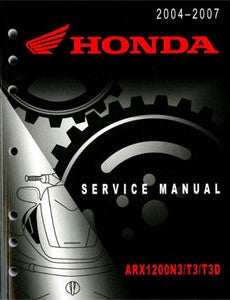 Read your owner’s manual before you hit the water.
Read your owner’s manual before you hit the water.Read you manual and familiarize yourself with a PWC’s operation before you ever go near the water. Realize a PWC, once started, will always have forward momentum. You can arrest this momentum by blocking or redirecting the thrust with the reverse lever. Start a craft in neutral to avoid this surge; use reverse, or brakes if so equipped, to control your approach to a dock. Practice and learn which way the bow will respond in reverse to avoid any surprises when there’s little room for error.
Engine won’t start? Check to make sure the lanyard is connected properly. If you can afford a spare, buy one and leave it in your tow vehicle…just in case you forget the main one at home. And yes, don’t forget to check the drain plug before ever backing down that ramp. Even the best have forgotten them once.
Getting Underway
PWC don’t have rudders; they rely on water, forcefully driven out a directional jet nozzle, to steer. Remove that thrust and you remove the craft’s directional control. It’s a fact many novice owners discover too late when they encounter an obstacle and release the throttle in a panic.
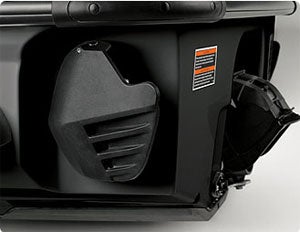 Off-throttle steering is helpful if you let off the gas quickly, but a turn of the bars and a quick burst of throttle is even better.
Off-throttle steering is helpful if you let off the gas quickly, but a turn of the bars and a quick burst of throttle is even better.Manufacturers have tried to address this situation with off-throttle steering solutions. Simply put, these systems detect an abrupt release of the throttle in combination with a full-lock turn of the handlebars and respond by increasing RPM a limited amount. This burst of propulsion is just enough to nudge the craft in the direction the driver is attempting to steer and hopefully avoid, or at least lessen, any collision.
The systems work, but drivers can do themselves a favor by simply remembering that thrust is their friend in these situations. Encounter an obstacle and a quick turn of the bars and a punch of the throttle will produce a much quicker response than relying on the onboard off-throttle system. Those systems are great, don’t get me wrong. But a skilled driver is often even better.
On that same note, realize that most PWC don’t have brakes. The only way to truly arrest forward momentum is to carefully deploy the reverse bucket. Sea-Doo has made this idea easy with its Intelligent Braking system, but you can employ the same idea (albeit not as precisely) on virtually any PWC with a reverse. Experiment with your craft in a controlled environment to get a feel for just how much reverse will slow you down…and how much it threatens to pitch you over the handlebars.
Running at Speed
Way back when I worked for a PWC rental operator on the beach. One thing he ingrained into customer’s heads was before you turn, look to the side you’re turning to make sure another craft isn’t right beside you, or following closely behind.
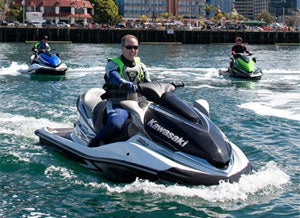 Keeping a little distance between you and your friend’s PWC is a good idea.
Keeping a little distance between you and your friend’s PWC is a good idea.There have been many reported accidents, even deaths, that occurred when one PWC driver simply turned right in front of the other. Most never realized the other driver was there. Wind, spray, and engine noise all drown out the sound of another craft. The only sense you can trust is sight. Turn, look, and make sure the water is clear. Then and only then make your move.
Another thing my rental friend taught me? Stay far apart. It’s tempting to ride closely together in open water, but if anything goes wrong — a wave pushes you off your path, you get distracted and wander off your line, you have to avoid something you suddenly spot in the water — that close promixity can have disastrous results. Stay a safe distance apart, a distance that gives you time to react without risking a collision.
Another simple thought when underway? Kill the engine if you begin to suck up weeds. Attempting to power through them simply packs the pump even tighter. If you kill the engine promptly, chances are good those weeds will float away, allowing you to restart and be on your way. Likewise, don’t be tempted to navigate through shallow waters simply because your craft has minimal draft. Small rocks, debris, and sand can all be sucked into the jet pump, damaging the impeller and clogging cooling lines.
After the Ride
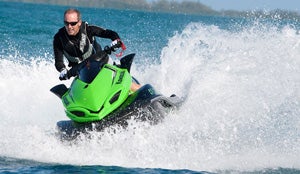 If you want to keep your PWC looking and running like new, be sure to flush out the cooling system and wash off your craft.
If you want to keep your PWC looking and running like new, be sure to flush out the cooling system and wash off your craft.I live in a coastal area, so flushing the saltwater out of my cooling system is a given after every single ride. As a new PWC owner, however, I made the common mistake of turning on the hose — and not turning on the engine. Result? Cylinders filled with water, and a long night spent trying to eliminate it and get my craft going again.
Remember this order: attach the flush hose, start the engine, and then turn on the water supply. Flush the engine for about 5-10 minutes, then turn the water off, and then and only then turn the engine off. It’s a good idea to rev the engine lightly after the water is off to rid the exhaust system of water. Keep it to about 15 seconds to avoid damage.
A rinse is a must in saltwater, but not a bad idea in any environment. Avoid the common mistake of putting a craft away wet. Open up the engine compartment and sponge up any water sitting in the bilge. Leaving it there will invite condensation, which can lead to corrosion in the long term. When finished, prop up the seat or hood cover to allow air to circulate.
Last but not least? Remove the lanyard and lock up the craft and trailer. Don’t let someone else have all the fun at your expense.
Related Reading
PWC Riding and Turning Techniques
How To Prevent Personal Watercraft Theft
Fuel-Saving Tips for Personal Watercraft
How to Repair Personal Watercraft Hull Damage
Get PersonalWatercraft.com in your Inbox!
Like PersonalWatercraft.com on Facebook
Comments
Most Popular

2025 Yamaha JetBlaster PRO 2-Up Review

2024 Kawasaki Jet Ski STX 160X Review

Remembering the Sea-Doo XP

Whatever Happened to the Wetbike?

2025 Yamaha JetBlaster Review





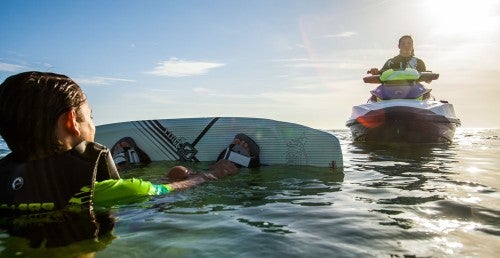







 Your Privacy Choices
Your Privacy Choices